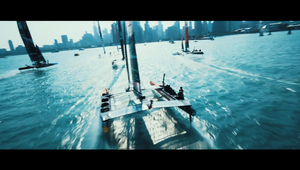
Respecting the Planet by Making Our Film Productions More Sustainable

Picture the scene: against the backdrop of Italy’s breathtaking Dolomites, a Michelin chef takes centre stage and shares his philosophies around people, produce, and preserving our planet. It’s the tale of one man’s mission to reconnect with the land and continue his ancestors’ techniques and traditions—not just to live more sustainably himself, but also to educate others on how to do so, too.
This scene is from our documentary series with Miele titled ‘Stories From Our Only Home’. The content aims to inspire others to accelerate or kick-start their journey towards sustainability, and the way we created the campaign also served this purpose. We shot the series with a very small crew, minimal energy consumption, and a reduced ecological footprint. This ultimately helped the film win an EMA Green Seal award for sustainable production.
Like many brands we partner with, we’re increasingly concerned with making marketing and advertising more environmentally friendly, focusing specifically on our film production processes. While this is a work in progress, we’ve established three main ways production teams can take better care of the planet.
Collaborate to find ways to be more climate-friendly together
Sustainability is a shared mission that transcends industries, which is why realising climate goals not only necessitates partnerships with organisations from within our industry such as Ad Green—which we co-founded in the Netherlands—but also requires collaboration between brands and their marketing services partners.
Whenever we work with a brand on a creative brief, we aim to find ways to make the task ahead more sustainable. In line with this, such mindful production means that our creatives are challenged to think outside the box when it comes to reducing our ecological impact, keeping in mind key aspects like travel and transportation, spaces and energy, materials used, and amount of waste. Ben Phillips, our creative director films & content, tells me that the documentary series with Miele is an excellent example.
“The production landscape continues to change, but our fundamental approach remains the same: be open to change, be solutions-oriented, and have an entrepreneurial mindset to tackle any issues,” Philips said. “The more we adopted a sustainable mindset, the more we felt an unexpected ripple effect of benefits. We travelled to the mountains by train, which gave us the opportunity to iron out the last details of our approach. The less we relied on heavier lighting and production equipment, the lighter and more agile we became—which is essential for this kind of filmmaking. And providing vegetarian options for the crew on set reduced the strain on the bathroom plumbing in the late afternoon.”

Moving film production from physical to virtual spaces
Virtual production, an incredible innovation in filmmaking, is not only about sustainability, but also about efficiency and being strategic in your decision-making. It serves more purposes than just one, and can deliver incredible results.
Virtual production enables us to shoot more scenes in a day than ever before, capture sunny scenes in the middle of winter, and obtain footage on a mountain top without the big climb. In other words, it allows us to bring any dreamy destination to our studio, which means we can stay close to home instead of having to journey from place to place.
Blending the real and the fantastical, we unlocked the incredible potential of Unreal Engine to take Sanofi’s audience into the night sky. As opposed to green screens, where directors and actors have to imagine what the final film might look like post-production, this virtual production technology merges the physical set with a digital environment and shows them where they are in real time. It also provides numerous set options and allows our crews to work faster than ever before, with backgrounds, props and lighting easily adjustable. As such, virtual production helps us reduce the use of physical materials in building a set. Who says you can’t have a wide range of artistic options, while also limiting waste?
Sourcing talent on the spot
Limiting—or even prohibiting—business flights and doing virtual productions instead may be most effective in reducing CO2, but this is not always possible. For example, when an international hotel group asks us to promote a brand-new luxury resort, it’s imperative we travel there to shoot real-life footage. In this case, we focus on finding the balance between cost-efficient production, versatile locations and reducing flights as much as possible, for example by teaming up with local talent, whether they be cast or production teams. This way, you’re not just supporting the local economy, like our production team in South Africa, but also creating opportunities for talent to collaborate with international partners, expand their portfolio and enhance their skills.
The secret is to sustain a delicate balance
One key lesson we’ve learned in aiming to make our film production processes more sustainable is that climate action is a cross-industry effort and requires collaboration between brands and their marketing services partners. But that’s not all. Realising climate goals in filmmaking goes beyond just focusing on sustainability. It’s about finding a balance between what’s best for the environment and what’s best for our client’s marketing budgets, the campaign, and other factors such as supporting local economies. How? Just try and test, fail fast, and improve even faster.















